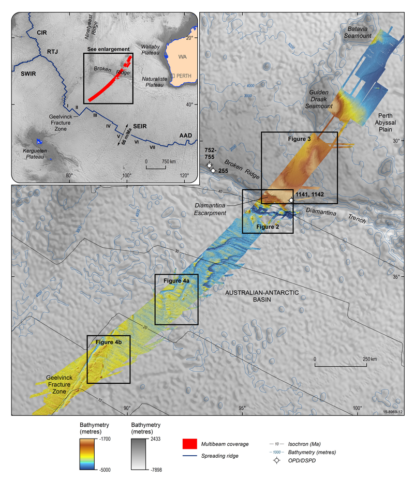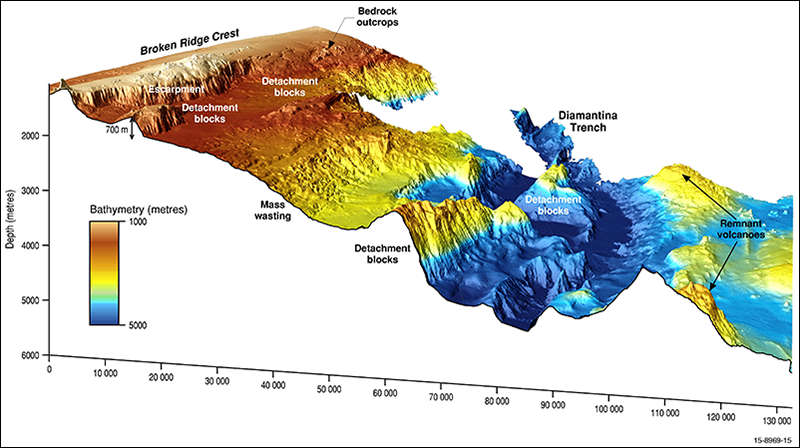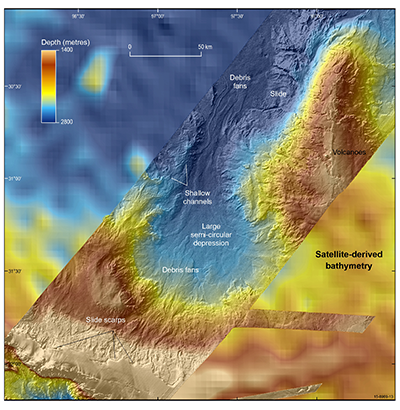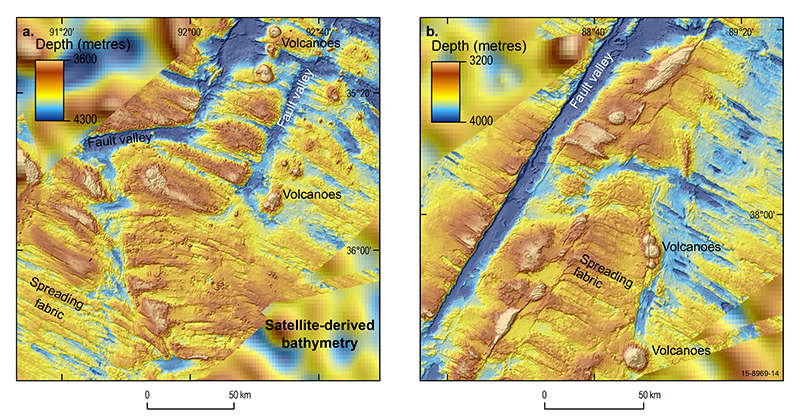The tragic disappearance of Malaysia Airlines flight MH370 on 8 March 2014 led to a deep-ocean search effort of unprecedented scale and detail. Between June 2014 and June 2016, geophysical survey teams aboard ships used echo sounding techniques to create state-of-the-art maps of the seafloor topography and profiles of the sediments below the ocean floor in a zone spanning about 279,000 square kilometers of the southeastern Indian Ocean.

The curved search swath is 75 to 160 kilometers wide, and it sweeps from northeast to southwest. It centers on Broken Ridge and extends roughly 2500 kilometers from the eastern flank of Batavia Seamount to the Geelvinck Fracture Zone (Figure 1). Aircraft debris found along the shores of the western Indian Ocean is consistent with drift modeling that indicates the aircraft entered the sea in the search area.
The data set that emerged from this search effort constitutes the largest high-resolution multibeam echo sounder (a type of sonar) mapping effort for the Indian Ocean, covering an area about the size of New Zealand. Previous ocean floor maps in this region had an average spatial resolution (pixel size) of more than 5 square kilometers, but the new maps resolve features smaller than 0.01 square kilometer (an area slightly larger than a soccer field). Crucially, the new data provided the geospatial framework for the last phase of the search, in which search teams deployed deepwater, high-resolution acoustic and optical imaging instruments with the ability to identify aircraft wreckage.
A Sharper Focus on the Ocean Floor
The global ocean covers 71% of Earth’s surface, yet the ocean floor remains poorly studied compared to the land surface. In particular, knowledge of ocean floor topography is sparse because light cannot penetrate the deep ocean and acoustic mapping techniques are relatively inefficient in mapping its floor. Most of the ocean floor (85%–90%) has been mapped indirectly using satellite-derived gravity data, which yield a spatial resolution of about 5 kilometers [Weatherall et al., 2015]. By comparison, topographic maps of even the most remote land areas on Earth resolve features approximately 50 meters across, and topographic maps of the Moon, Mars, and Venus resolve 100-meter features [Copley, 2014].
The high-resolution multibeam echo sounder data set that emerged from this search effort covered an area about the size of New Zealand.
Ship-mounted multibeam echo sounders that use sound waves that echo off the ocean floor provide much finer and more accurate topographic data for the deep ocean floor with a spatial resolution (as distinct from a vertical resolution) of at least 100 m in 5000-meter water depths. However, only 10%–15% of the ocean basins have been mapped using multibeam echo sounders [Weatherall et al., 2015].
This technique also records acoustic backscatter from the ocean floor, which can be used to distinguish between hard rock and soft sediment. Such fundamental spatial information is essential for characterizing the physical features of the ocean floor, for making inferences on geological and oceanographic processes, and for identifying the habitats of species that live on the ocean floor.
A Complex Region
Beyond the continental margins, toward the open sea, the floor of the Indian Ocean is a complex mosaic of normal oceanic crust (not associated with hot spots and other anomalies), submarine plateaus and ridges, seamounts, sea knolls, and microcontinents. Various processes, including seafloor spreading (including ridge jumps), flood and hot spot magmatism, and tectonism, produce a variety of features.
Only 10%–15% of the ocean basins have been mapped using multibeam echo sounders.
The MH370 search area includes all of the major elements of the mosaic, and it lies in water depths between 635 and 6300 meters (Figure 1). The search teams mapped most of the area with a 30-kilohertz multibeam echo sounder system (Kongsberg EM302, M/V Fugro Equator), and they mapped much smaller areas with 12-kilohertz systems, which can reach the deeper ocean floor (Kongsberg EM122, M/V Fugro Supporter; Reson SeaBat 8150, Chinese PLA Navy ship Zhu Kezhen).
Here we highlight three examples from this shipboard multibeam echo sounder data set that are helping to illuminate the geologic development of this portion of the Indian Ocean.
Submarine Plateau Rifting and Breakup
Broken Ridge and the Kerguelen Plateau formed mostly as a contiguous large igneous province in Cretaceous time [Coffin et al., 2000]. They subsequently experienced rifting and were eventually separated by seafloor spreading along the Southeast Indian Ridge (SEIR) 43 million years ago [Mutter and Cande, 1983].
The southern flank of Broken Ridge, known as the Diamantina Escarpment, documents the rifting, plunging more than 5100 meters from its crest (638 meters of water depth) into a deep trough (5800 meters of water depth). This rifted flank includes escarpments rising more than 1000 m above the ocean floor, slopes as steep as 67°, and fault blocks about 12 by 25 kilometers in size and rising more than 1200 meters above their base (Figure 2).

The new multibeam echo sounder data, integrated with preexisting seismic reflection and drilling data, illuminate exposed igneous basement rock, prerift sedimentary sections, and overlying sediment that accumulated on the ocean floor during (hemipelagic sediment) and after (pelagic sediment) rifting.
The morphology and seismic stratigraphy of the Diamantina Escarpment indicate that the mode of rifting resembled an orthogonal rift model, in which faults develop parallel to the axis of spreading. Between the faults, a series of elongated blocks of crustal material, grabens, steps down into a deep trough and abuts the spreading ridge volcanics [Karner and Driscoll, 1993].
Seafloor Erosion
North of its rifted southern flank, Broken Ridge generally has subtle relief, with igneous basement rocks overlain by sedimentary rock and pelagic sediment [e.g., Coffin et al., 2000]. In places, slides and debris flows have reworked sediment downslope.

A large depression, about 90 kilometers in diameter and with about 500 meters of relief, lies some 70 kilometers northeast of the crest of Broken Ridge (Figure 3). Numerous crosscutting retrogressive slides (where the collapsing area extends progressively higher up the slope) and debris flows dissect the flanks of the depression, recording episodes of sediment flow, with slide scarps as much as 180 meters high and 10 kilometers wide and debris fans more than 150 kilometers long.
Tectonic Spreading Fabric
South of Broken Ridge, normal oceanic crust of the Australian-Antarctic Basin has formed along the SEIR at intermediate spreading rates of 59–75 millimeters per year [Small et al., 1999; Müller et al., 2008]. The shipboard multibeam echo sounder data swath traverses a region of crust north of the SEIR that is some 10 to 40 million years old, obliquely cutting across tectonic seafloor spreading fabric consisting of elongated abyssal ridges and fracture zones (Figure 1).
Oceanic crust in this region, which lies in water depths of 2200 to 5000 meters, is characterized by SEIR and paleo-SEIR segments some 200 to 500 kilometers long (Figure 1) [Small et al., 1999]. In the search area, fracture zone valleys are as much as 900 meters deep and 12 kilometers wide. The abyssal ridges have as much as 200 meters of relief and are more than 70 kilometers long (Figure 4).

Discontinuities along the paleo-SEIR not associated with transform faults and more than 150 sea knolls and seamounts are also common (Figure 4). Volcanoes occur in isolation and in chains, forming semiconcentric structures, some as high as 1500 meters, with diameters of about 500 meters to more than 15 kilometers and slopes of about 10° to 30°.
Gaining Useful Knowledge from a Tragic Event
The new data highlight the topographic complexity of the ocean floor and provided a framework for deploying deepwater instruments in the search for MH370 wreckage.
The new multibeam echo sounder data highlight the topographic complexity of the ocean floor and provided a framework for deploying deepwater instruments in the search for MH370 wreckage. The data also revealed details of the tectonic, sedimentary, and volcanic processes that formed this region of the ocean. This effort demonstrates the breadth and depth of knowledge that will be gained as the remaining 85% to 90% of the global ocean is mapped at similar resolution.
Acknowledgments
We thank the Geoscience Australia team, especially Tanya Whiteway and Maggie Tran, for project management; Maggie Tran, Justy Siwabessy, Michele Spinoccia, Jonah Sullivan, and Jonathan Weales for data processing and mapping; and Silvio Mezzomo and David Arnold for the figures. We are thankful for insightful reviews by Scott Nichol and Ron Hackney of Geoscience Austrialia and two anonymous reviewers. The search for MH370 was managed by the Australian Transport Safety Bureau and the Joint Agency Coordination Centre for the Malaysian government. We thank the Fugro Survey Pty. Ltd. team from Perth, Australia, and the masters and crews of M/V Fugro Equator, M/V Fugro Supporter, and Zhu Kezhen for shipboard multibeam echo sounder data acquisition.
References
Argus, D. F., R. G. Gordon, and C. DeMets (2011), Geologically current motion of 56 plates relative to the no net rotation reference frame, Geochem. Geophys. Geosyst., 12, Q11001, https://doi.org/10.1029/2011GC003751.
Coffin, M. F., F. A. Frey, and P. J. Wallace (2000), Proceedings of the Ocean Drilling Program, Initial Reports, vol. 183, 101 pp., Ocean Drill. Program, College Station, Texas.
Copley, J. T. (2014), Just how little do we know about the ocean floor?, Conversation, 9 Oct. 2014, https://theconversation.com/just-how-little-do-we-know-about-the-ocean-floor-32751.
Karner, G. D., and N. W. Driscoll (1993), Rift flank topography and extensional basin architecture: Formation of Broken Ridge, southeast Indian Ocean, An. Acad. Bras. Cienc., 65, suppl. 2, 263–294.
Müller, R. D., M. Sdrolias, C. Gaina, and W. R. Roest (2008), Age, spreading rates, and spreading asymmetry of the world’s ocean crust, Geochem. Geophys. Geosyst., 9, Q04006, https://doi.org/10.1029/2007GC001743.
Mutter, J. C., and S. C. Cande (1983), The early opening between Broken Ridge and the Kerguelen Plateau, Earth Planet. Sci. Lett., 65, 369–376, https://doi.org/10.1016/0012-821X(83)90174-7.
Sandwell, D. T., R. D. Müller, and W. H. F. Smith (2014), New global marine gravity model from Cryo-Sat-2 and Jason-1 reveals buried tectonic structure, Science, 346, 65–67, https://doi.org/10.1126/science.1258213.
Small, C., J. R. Cochran, J.-C. Sempéré, and D. Christie (1999), The structure and segmentation of the Southeast Indian Ridge, Mar. Geol., 161, 1–12, https://doi.org/10.1016/S0025-3227(99)00051-1.
Weatherall, P., K. M. Marks, and M. Jakobsson (2015), A new digital bathymetric model of the world’s oceans, Earth Space Sci., 2, 331–345, https://doi.org/10.1002/2015EA000107.
Author Information
Kim Picard (email: [email protected]) and Brendan Brooke, Geoscience Australia, Canberra, ACT; and Millard F. Coffin, Institute for Marine and Antarctic Studies, University of Tasmania, Hobart, Australia; and Woods Hole Oceanographic Institution, Woods Hole, Mass.
Editor’s note: For more on how much of the seafloor under commercial flight paths remains unmapped, read this opinion piece on Eos.org.
Citation:
Picard, K.,Brooke, B., and Coffin, M. F. (2017), Geological insights from Malaysia Airlines flight MH370 search, Eos, 98, https://doi.org/10.1029/2017EO069015. Published on 06 March 2017.
Text © 2017. The authors. CC BY 3.0
Except where otherwise noted, images are subject to copyright. Any reuse without express permission from the copyright owner is prohibited.

